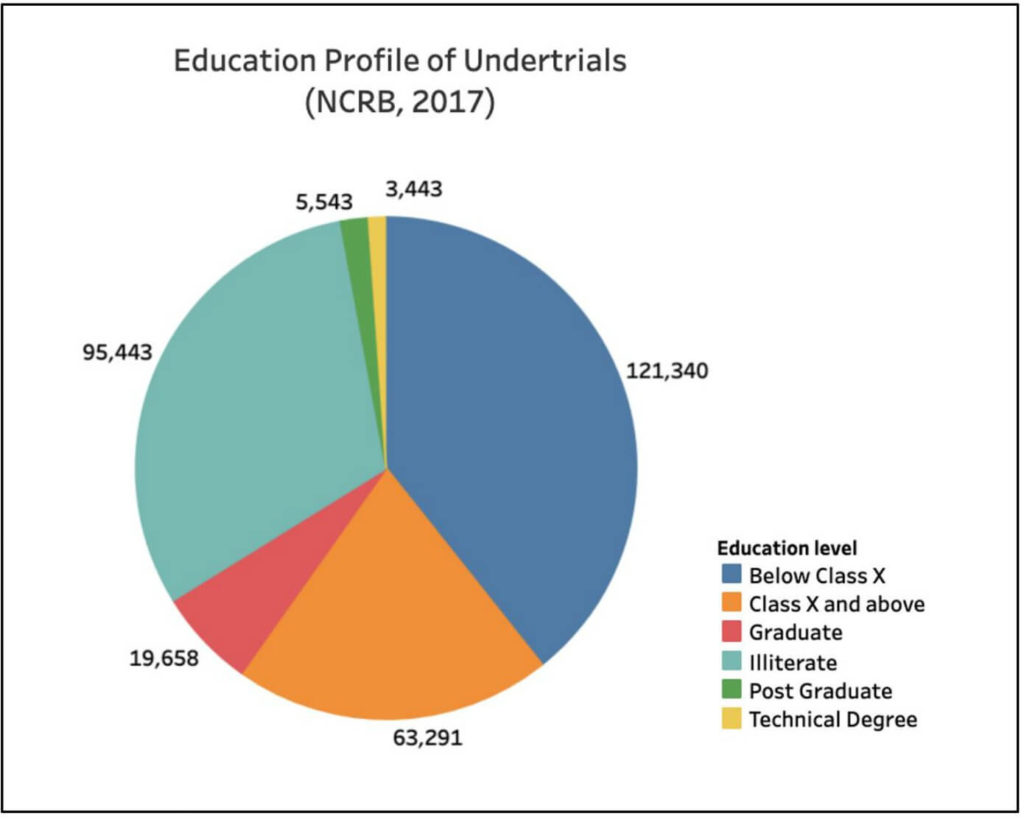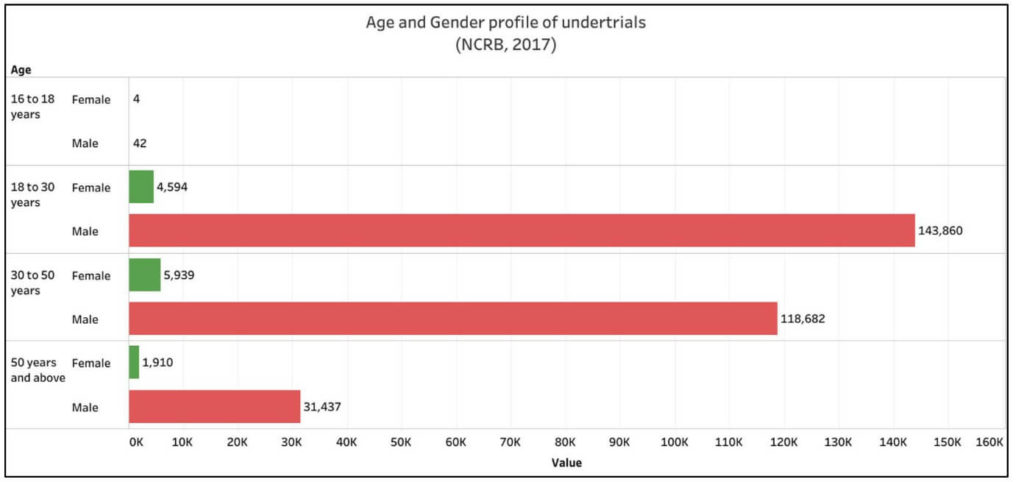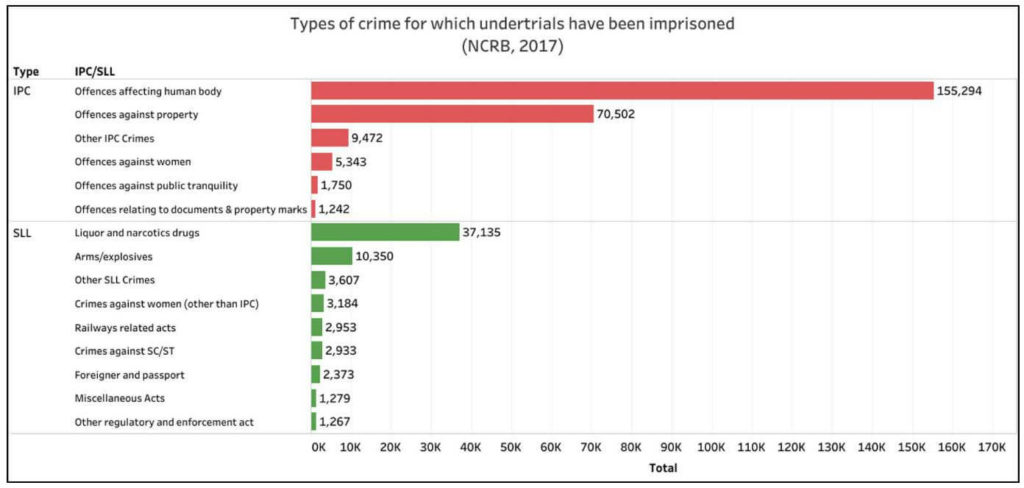[orc]The NCRB’s 2017 report on prison statistics reveals that the proportion of under-trials in Indian prisons has gone up by about 5%. Out of the more than 3 lakh under-trials languishing in jails by end of 2017, more than 70% are either illiterate or those who studied only up to Class X, implying that most of these are from the disadvantaged communities.
The Prison Statistics for 2017 by the National Crime Records Bureau (NCRB) revealed that Indian jails are over-crowded like in the previous years. The occupancy ratio was 115.1% which in other words means that in a place which can accommodate 100 people, 115 people have been cramped. Prime reason for the congestion is the incarceration of under-trials.
Some under-trials are confined to prisons for a longer-term than they may actually have to serve because of delay in court hearings or delay in investigation by police officers. Some private studies have also pointed out that it is the disadvantaged who make up the bulk of these under-trials. Imprisonment, especially if the under trial is proven innocent later, takes a toll on their health, social life and future prospects to lead a fruitful life.
Under-trials are those people who have been imprisoned while awaiting trial or waiting for the court verdict. They have not been convicted as yet. In 2017, the number of under-trials witnessed an increase of 5.3% compared to 2016.
Every 2 out of 3 prisoners is an under-trial
As on 31 December 2017, around 4.5 Lakh people were behind bars in India. Of this, more than 3 lakh prison inmates were under-trials. They constituted 68.4% of the total prisoners in India. The trend hasn’t changed in many years. More than 51% of the under-trials are in district jails and 35.8% in central jails. Of the total under-trials, 96% of them are male and 4% are female. Among the female under-trials, 1,077 women had 1,252 children with them in prison.
Uttar Pradesh accounts for the maximum number of under-trials
Uttar Pradesh has reported the largest number of under-trials in prisons. More than 71% of the prison inmates in Uttar Pradesh are under-trials. They accounted for 22% of the total number of under-trials in India in 2017. Bihar and Maharashtra accounted for 11% and 8% of the total under-trials respectively. Together, these three states accounted for 41% of the under-trials in India in 2017.
70.2% of the under-trials were illiterate or had an education only up to class X
The education profile of the under-trials further substantiates the fact that the majority of them are from the disadvantaged sections of society. As per the 2017 data, it is observed that 70.2% of the under-trials were either illiterate or had education only up to class X. About 20% had an education above class X but not graduation. Graduates comprised only about 6% of the under-trials. Those who were postgraduates (and above) and those with a technical degree or diploma together constituted to a little less than 3% of the under-trials in 2017.

91% of the under-trials were imprisoned in their own state
About 2.8 Lakh under-trials (90.8%) belonged to the state in which they were imprisoned. The rest of 26,000 odd under-trials did not belong to the state where they were imprisoned in. A total of 2,250 under-trials were from other countries.
Of the foreign nationals, 25% were reported from West Bengal alone. Maharashtra reported 13.5% and Delhi reported 13%. Foreign under-trials comprised 46% of the foreign prison inmates in the country. Almost 50% of them were between 30 to 50 years of age. Among the foreign under-trials, 869 (38.6%) were from Bangladesh, 400 (17.7%) from Nepal and 444 (19.7%) from Nigeria. Other under-trials in significant numbers who are foreign nationals include those from Pakistan, Myanmar and Sri Lanka.
Majority of the under-trials between 18 to 30 years of age
Majority (48.4%) of the under-trials belonged to the age group of 18 to 30 years followed by 40.7% in the age group of 30 to 50 years. There were 46 under-trials in the 16 to 18 years age group and 42 of them were incarcerated in West Bengal alone.

As of end 2017, more than 4700 under-trials had completed a period of 5 years under confinement
More than one third the under-trial inmates (36%) had been detained for less than three months as on 31 December 2017. Around 68,000 under-trials (22%) had been in the jail for a period ranging from 3 to 6 months and another 50,400 (16%) had been imprisoned for 6 to 12 months. Thus, a total of 74% of under-trials were in prison for a period of 12 months or less.
4,786 under-trials had already been in prison for more than 5 years as of 31 December 2017. Uttar Pradesh alone reported 36.8% of them. That is, 1,794 under-trials out of the 4,786 were confined in the jails in Uttar Pradesh for more than 5 years. Gujarat and Maharashtra had reported 684 and 597 under-trials respectively who had been in prison for more than 5 years.

Many cases of mental illness were reported
As per available data, a total of 3200 under-trials were suffering from mental illnesses with 515 such cases in Uttar Pradesh, 401 in Maharashtra, 375 in Odisha and 314 in West Bengal.
What crimes are the under-trials booked for?
Under the Indian Penal Code, 2.43 lakh under-trials have been kept in prisons. The greatest number of under-trials, about 1.55 lakh persons have been taken into custody under offences affecting the human body with murder being the reason behind the imprisonment of 65,086 under-trials. Another 25,000 under-trials were those accused of attempt to murder. More than 28,000 were accused of rape. Offences against property such as theft, burglary, arson, etc. is the reason behind the incarceration of about 70,000 under-trials.

More than 65,000 under-trials have been imprisoned under Special and Local Laws (SLL). Liquor and narcotic drugs were reported to be the most prominent reason behind the imprisonment of under-trials under SLL. Almost 50% of those under-trials booked under SLL fall into this category.
Under Section 463A of CrPC only 0.5% of the under-trials were released in 2017
In 2017, 14.45 Lakh under-trials were released. Of these, 13.15 Lakh were released on bail. The trial courts acquited another 85,839. Of this, 32,204 under-trials were acquitted in Karnataka alone. Maharashtra, Madhya Pradesh and Chhattisgarh had together acquitted 14,151 under-trials. About 21,078 were released on appeal to higher courts. Under Section 436-A of the Code of Criminal Procedure (CrPC), 1074 under-trials were released including 1062 male and 12 female inmates. Another 1773 male and 20 female under-trials were eligible for premature release.
What is Sec 436-A of CrPC?
Section 436-A of CrPC was included in 2005. The law permits those under-trials who have been imprisoned for more than half of the maximum period of imprisonment specified for the offence under that law for which they are accused, to be released on their personal bond with or without sureties. In spite of such a provision, the number of under-trials being released is considerably low. Less than 0.5% of the under-trials were released under 436-A in 2017.
It was also observed that those who were illiterate or semi-literate were kept in prisons whether or not they were found guilty. Since 2016, the NCRB has not added the social background of the under-trials. However, data from earlier reports and other studies have reported that about 70% of the under-trials were those belonging to SC, ST or OBC groups. Despite the intervention of the Supreme Court, not much progress is seen in the release of under-trials under the existing provisions. It is high time that governments follow the directions of the Supreme Court in letter & spirit.
Featured Image: Under-trial prisoners


